To Shudder in the Sign of Mimesis: Towards a Recovery of Unreduced Experience in Theodor W. Adorno
DOI:
https://doi.org/10.54103/2039-9251/22237Parole chiave:
Adorno, mimesis, experience, shudderAbstract
In the last decades, an enthusiastic and undivided attention has been firmly dedicated to Adorno’s notion of mimesis. Highly enigmatic and resistant to an easy comprehension, this concept has often been regarded as a fundamental cornerstone of Adorno’s philosophy. In actual fact, the meanings and uses he has endowed the term with are so pervasive and diffuse that its imbrication in Adorno’s main philosophemes transcends the strict realm of art, showing a substantial entanglement between the aesthetic dimension and the epistemic, the anthropological and the social ones. More precisely, this paper aims to investigate his specific conception of mimesis as that faculty that could contribute to heal that historical process of experiential impoverishment that affects modern life. To the mimetic comportment Adorno associates a productive openness to the other that allows the subject to touch and to be touched by the object, without coercively subsuming it. Thereby, through a renewed interplay between mimesis and rationality, Adorno hopes to restore the possibility of a full and unreduced experience.
Riferimenti bibliografici
Adorno, T. W., Aesthetic Theory (1970), ed. and transl. by R. Hullot-Kentor, Continuum, London-New York 2002.
Adorno, T. W., Minima Moralia. Reflections on a Damaged Life, Verso, London-New York 2005.
Adorno, T. W., Negative Dialectics (1966), transl. by E. B. Ashton, Routledge, London-New York 2004.
Bronner, S. E., Of Critical Theory and its Theorists, Blackwell, Oxford 1994.
Crawford, R., Index of the Contemporary: Adorno, Art, Natural History, in “Evental Aesthetics”, VII/2, 2018, pp. 32-71.
Foster, R., Adorno. The Recovery of Experience, State University of New York Press, Albany 2007.
Gebauer, G., Wulf, C., Mimesis: The History of a Notion, 2013, available at http://dx.doi.org/10.2139/ssrn.3698687
Goehr, L., Dissonant Works and the Listening Public, in T. Huhn (ed. by), The Cambridge Companion to Adorno, Cambridge University Press, Cambridge 2004.
Habermas, J., The Theory of Communicative Action (1981), vol. 1 ((Reason and the Rationalization of Society), transl. by T. McCarthy, Beacon Press, Boston 1984.
Horkheimer, M., Adorno, T. W., Dialectic of Enlightenment: Philosophical Fragments, Stanford University Press, Stanford 2002.
Hulatt, O., Reason, Mimesis, and Self-Preservation in Adorno, in “Journal of the History of Philosophy”, LIV/1, 2016, pp. 135-151.
Huyssen, A., Of Mice and Mimesis: Reading Spiegelman with Adorno, in “New German Critique”, LXXXI, 2000, pp. 65-82.
Jay, M., Mimesis and Mimetology: Adorno and Lacoue¬-Labarthe, in Huhn, T., Zuidervaart L. (ed. by), The Semblance of Subjectivity: Essays in Adorno’s Aesthetic Theory, MIT Press, Cambridge 1997.
Koch, G., Vöhler, M., Voss C., Zur Einführung: Die Mimesis und Ihre Künste, in id. (hrsg. v.), Die Mimesis und ihre Künste, Brill Fink, Paderborn 2010.
Matteucci, G., L’utopia dell’estetico in Adorno, in “Rivoluzioni Molecolari”, I, 2017.
Mussell, S., Mimesis Reconsidered: Adorno and Tarkovsky contra Habermas, in “Film-Philosophy”, XVII/1, 2013, pp. 212-233.
Paudyal, B. P., Mimesis in Adorno’s Aesthetic Theory, in “Journal of Philosophy”, IV/8, 2009, pp. 1-10.
Roberts, D., Art and Enlightenment: Aesthetic Theory after Adorno, University of Nebraska Press, Lincoln 1991.
Singh, S., The Aesthetic Experience of Shudder Adorno and the Kantian Sublime, in N. Ross (ed. by), The Aesthetic Ground of Critical Theory: New Readings of Benjamin and Adorno, Rowman & Littlefield, London-New York 2015.
Thompson, M. J., Adorno’s Reception of Weber and Lukács, in P. E. Gordon, E. Hammer, M. Pensky (ed. by), A Companion to Adorno, Wiley Blackwell, Hoboken 2020.
Dowloads
Pubblicato
Fascicolo
Sezione
Licenza
Copyright (c) 2024 Villani

Questo lavoro è fornito con la licenza Creative Commons Attribuzione - Condividi allo stesso modo 4.0.
Gli autori che pubblicano su questa rivista accettano le seguenti condizioni:
1. Gli autori mantengono i diritti sulla loro opera e cedono alla rivista il diritto di prima pubblicazione dell'opera, contemporaneamente licenziata sotto una Licenza Creative Commons - Attribuzione - Condividi allo stesso modo 4.0 internazionale che permette ad altri di condividere l'opera indicando la paternità intellettuale e la prima pubblicazione su questa rivista.
2. Gli autori possono aderire ad altri accordi di licenza non esclusiva per la distribuzione della versione dell'opera pubblicata (es. depositarla in un archivio istituzionale o pubblicarla in una monografia), a patto di indicare che la prima pubblicazione è avvenuta su questa rivista.
3. Gli autori possono diffondere la loro opera online (es. in repository istituzionali o nel loro sito web) prima e durante il processo di submission, poiché può portare a scambi produttivi e aumentare le citazioni dell'opera pubblicata (Vedi The Effect of Open Access).





